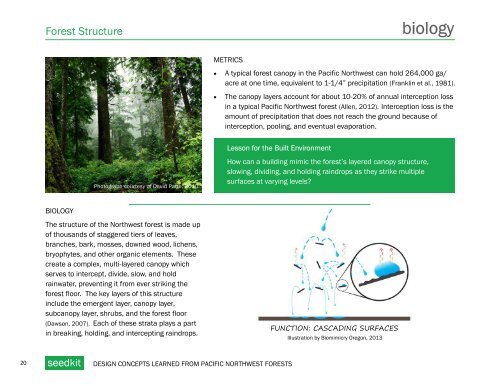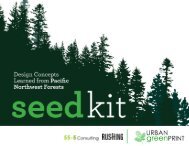Create successful ePaper yourself
Turn your PDF publications into a flip-book with our unique Google optimized e-Paper software.
Forest Structure<br />
biology<br />
METRICS<br />
· A typical forest canopy in the Pacific Northwest can hold 264,000 ga/<br />
acre at one time, equivalent to 1-1/4” precipitation (Franklin et al., 1981).<br />
· The canopy layers account for about 10-20% of annual interception loss<br />
in a typical Pacific Northwest forest (Allen, 2012). Interception loss is the<br />
amount of precipitation that does not reach the ground because of<br />
interception, pooling, and eventual evaporation.<br />
Lesson for the Built Environment<br />
Photograph courtesy of David Patte, 2010<br />
How can a building mimic the forest’s layered canopy structure,<br />
slowing, dividing, and holding raindrops as they strike multiple<br />
surfaces at varying levels?<br />
BIOLOGY<br />
The structure of the Northwest forest is made up<br />
of thousands of staggered tiers of leaves,<br />
branches, bark, mosses, downed wood, lichens,<br />
bryophytes, and other organic elements. These<br />
create a complex, multi-layered canopy which<br />
serves to intercept, divide, slow, and hold<br />
rainwater, preventing it from ever striking the<br />
forest floor. The key layers of this structure<br />
include the emergent layer, canopy layer,<br />
subcanopy layer, shrubs, and the forest floor<br />
(Dawson, 2007). Each of these strata plays a part<br />
in breaking, holding, and intercepting raindrops.<br />
FUNCTION: CASCADING SURFACES<br />
Illustration by Biomimicry Oregon, 2013<br />
20 seedkit DESIGN CONCEPTS LEARNED FROM PACIFIC NORTHWEST FORESTS



